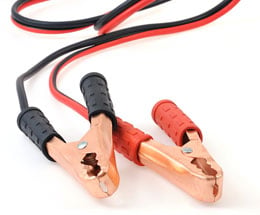 Have you ever jumped into your car, turned the key, and nothing happened? If so, did thoughts like this start racing through your head?
Have you ever jumped into your car, turned the key, and nothing happened? If so, did thoughts like this start racing through your head?
- I wonder what’s wrong?
- What am I going to do now?
- Who can I call?
- I hope this isn’t going to be expensive.
A dead battery can occur any time. Stephanie, our marketing manager, knows that only too well. Her car battery failed in her son’s school parking lot in August.
While dead car batteries aren’t just a winter phenomenon, as the temperatures plummet, they can become dangerous at this time of year.
A car battery can last an average of five to seven years if the vehicle is driven regularly. A car that’s kept in storage and not driven for an extended period may need a new battery sooner.
Before a car battery goes completely dead and leaves you stranded, it does give some warning signs. These include:
1. Slow engine crank. A worn-out battery will turn over your car at a slower rate. If your car doesn’t sound right or it takes longer to start, this could be a telltale sign.
2. Warning lights. If battery power is weak, a warning light may appear on your dashboard. In newer cars, this may show as a battery symbol. If this light goes on while you’re driving, don’t turn off your car! If your car doesn’t have a warning light but it’s hard to get it started, keep the car running until you get to your final destination.
3. Crusty connections. Today’s batteries are mostly maintenance free; however, corrosion around the battery posts may indicate a leaking battery. If you notice a lot of corrosion, clean off the posts. Corroded posts can lead to difficulty starting your car.
4. The car is misbehaving. Features in your car may be acting up. For example, your power windows may not open and close efficiently. In addition, your radio may not work correctly.
5. Oil change. When you get your oil changed, some garages will run a complementary battery test. If the mechanic tells you your battery is underperforming and it’s five to seven years old, you may want to have a new one installed.
If you’re left stranded and need a jump-start, here are the appropriate steps to get you back on the road.
1. Take a deep breath. I’ve been in this position before. Once help arrives, there’s a lot of commotion. Always think before you act. If you’re on the side of the road, pay attention to your surroundings. Before exiting your car, make sure it’s safe. If you’re in a parking lot, pay attention to swinging doors and other cars around you.
2. Position the vehicles appropriately. Once help arrives, position the vehicle with the dead battery and the running vehicle so they’re facing each other. If you’re in a parking lot, this may be difficult so get them as close together as possible. Automatic transmission cars should be placed in park and manual transmission cars should be put in neutral. For extra safety, be sure to use the parking brakes in both cars.
3. Turn off the running car. Once the cars are positioned appropriately, turn off the radio, headlights, interior lights, etc. Once this has been done, turn the car off.
4. Identify the battery terminals. The positive has a red indicator or a plus (+) sign. The negative terminal has a black indicator or a negative (-) sign.
5. Identify the jumper cables. The red clamp is positive and the black clamp is negative. A stripe on the cable may also indicate the positive cable.
6. Attach the jumper cables. It’s important to attach the jumper cables in this order.
- Attach the positive cable (red) to the positive terminal on the dead battery.
- Attach the positive cable (red) to the positive terminal on the functioning battery.
- Attach the negative cable (black) to the negative terminal on the functioning battery. Please note the cables are now live! Be careful in handling the remaining negative cable.
- Attach the negative cable (black) to a non-painted piece of metal or a bolt on the car with the dead battery. Make sure the cable is clear from moving parts.
7. Ladies and gentleman start your engines. Start the car with the functioning battery and allow it to run for one to two minutes. Next, try starting the car with the dead battery. The engine of the good car can be idled at 3,000 rpms to help transfer the energy through the jumper cables.
8. Disconnect the jumper cables. Now that the car with dead battery is running, it’s time to disconnect the jumper cables.
- Start by disconnecting the black or negative cable on the previously dead battery.
- Disconnect the black or negative cable on the functioning battery.
- Disconnect the red or positive cable on the functioning battery.
- Disconnect the red or positive cable on the previously dead battery.
If the car with the dead battery didn’t start, try:
- Re-connecting the cables following the steps in #6.
- Allow the functioning car to run five to ten minutes with the jumper cables attached to the dead car.
- Consider calling a tow truck.
Here are some additional resources that can help you become more familiar with the jump starting process.
How to Jump a Car (Infographic)
How to Jump Start a Car Battery – Advanced Auto Parts (Video)
A Jumper Cable Buyer’s Guide
Consumer Reports Car Batteries Buying Guide
Sources:
https://www.pepboys.com/car_care_corner/car_care_basics/maintenance/jump_starting_your_battery_using_another_car/
https://blog.firestonecompleteautocare.com/batteries/car-battery-problems-when-is-it-time-for-a-new-battery/
https://www.testingautos.com/when-to-replace-car-battery
SOURCE: WEST BEND, Scott Stueber on Nov 22, 2016 9:12:34 AM
Leave a Reply